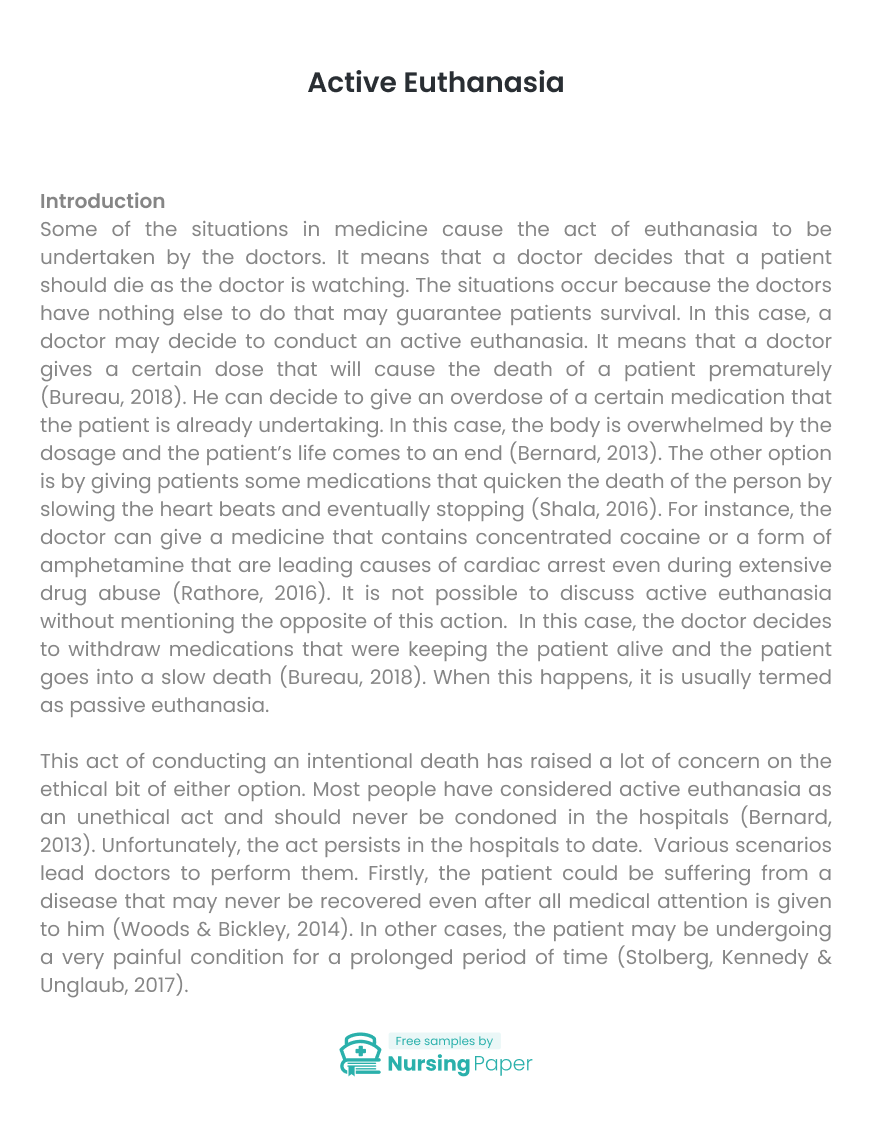
Introduction
Some of the situations in medicine cause the act of euthanasia to be undertaken by the doctors. It means that a doctor decides that a patient should die as the doctor is watching. The situations occur because the doctors have nothing else to do that may guarantee patients survival. In this case, a doctor may decide to conduct an active euthanasia. It means that a doctor gives a certain dose that will cause the death of a patient prematurely (Bureau, 2018). He can decide to give an overdose of a certain medication that the patient is already undertaking. In this case, the body is overwhelmed by the dosage and the patient’s life comes to an end (Bernard, 2013). The other option is by giving patients some medications that quicken the death of the person by slowing the heart beats and eventually stopping (Shala, 2016). For instance, the doctor can give a medicine that contains concentrated cocaine or a form of amphetamine that are leading causes of cardiac arrest even during extensive drug abuse (Rathore, 2016). It is not possible to discuss active euthanasia without mentioning the opposite of this action. In this case, the doctor decides to withdraw medications that were keeping the patient alive and the patient goes into a slow death (Bureau, 2018). When this happens, it is usually termed as passive euthanasia.
This act of conducting an intentional death has raised a lot of concern on the ethical bit of either option. Most people have considered active euthanasia as an unethical act and should never be condoned in the hospitals (Bernard, 2013). Unfortunately, the act persists in the hospitals to date. Various scenarios lead doctors to perform them. Firstly, the patient could be suffering from a disease that may never be recovered even after all medical attention is given to him (Woods & Bickley, 2014). In other cases, the patient may be undergoing a very painful condition for a prolonged period of time (Stolberg, Kennedy & Unglaub, 2017). When the doctor realizes that there is no way the pain will come to an end, he poses a proposal that may terminate the person’s life. In some circumstances, a person may undergo a prolonged coma and for that reason, the doctors may have no hope that he will wake from the condition (Shala, 2016). However, a doctor has no authority to conduct the euthanasia before consulting important people. Therefore, he suggests the proposal but the authority must be either from a patient or from a close family member mostly spouses or parents (Woods & Bickley, 2014).


Conclusion
In addressing the matter in an ethical way, the society has argued whether any euthanasia is ethically and medically right. There are mixed reactions regarding the matter where some believe it is ethically right. They claim that it is not good to see a human being suffer while one can do something about ending his suffering (Bernard, 2013). For that thought, they believe that ending the person’s life is a way of ending his suffering. However, another school of thought believes that no one has the right to end someone’s life since only God has authority over life (Stolberg, Kennedy & Unglaub, 2017). Therefore, a patient needs to be taken care until demise that will come as a result the “act of God”. However, even in the mix of all these debates, there are leading trends that some people are willing to give authority to active euthanasia (Bernard, 2013). It means that when they are still healthy, they give physicians the go-ahead to end their suffering when they fall sick. Therefore, active euthanasia continues to be practiced despite different mixed reactions from the society on ethics behind the act.
1. Bernard. (2013). Resolving ethical dilemmas : a guide for clinicians. Philadelphia, Pa: Lippincott Williams & Wilkins.
2. Bureau, O. (2018). Explainer: How is active euthanasia different from passive euthanasia. https://www.outlookindia.com/. Retrieved 10 March 2018, from https://www.outlookindia.com/website/story/explainer-how-is-active-euthanasia-different-from-passive-euthanasia/309316
3. Rathore, G. (2016). List of Major Medicines & Drugs that Cause Cardiac Arrest. iTervis. Retrieved 10 March 2018, from http://www.itervis.com/drugs-that-cause-cardiac-arrest/
4. Shala, I. (2016). The Debate Over Euthanasia and Human Rights. European Scientific Journal, 12(8). http://dx.doi.org/10.19044/esj.2016.v12n8p73
5. Stolberg, M., Kennedy, L. & Unglaub, L. (2017). A history of palliative care, 1500-1970 : concepts, practices, and ethical challenges. Cham, Switzerland: Springer.
6. Woods, M., & Bickley, A. (2014). Nurses and the euthanasia debate: reflections from New Zealand. International Nursing Review, 62(1), 13-20. http://dx.doi.org/10.1111/inr.12145



The download will start shortly.

The download will start shortly.
 Subject:
Nursing
Subject:
Nursing  Number of pages: 4
Number of pages: 4  Subject:
Nursing
Subject:
Nursing  Number of pages: 5
Number of pages: 5  Subject:
Medicine
Subject:
Medicine  Number of pages: 2
Number of pages: 2  Subject:
Medicine
Subject:
Medicine  Number of pages: 3
Number of pages: 3  Subject:
Health and Social Care
Subject:
Health and Social Care  Number of pages: 6
Number of pages: 6  Subject:
Medicine
Subject:
Medicine  Number of pages: 11
Number of pages: 11  Subject:
Health and Social Care
Subject:
Health and Social Care  Number of pages: 7
Number of pages: 7  Subject:
Medicine
Subject:
Medicine  Number of pages: 7
Number of pages: 7  Subject:
Health and Social Care
Subject:
Health and Social Care  Number of pages: 2
Number of pages: 2  Subject:
Health and Social Care
Subject:
Health and Social Care  Number of pages: 846
Number of pages: 846  Subject:
Health and Social Care
Subject:
Health and Social Care  Number of pages: 7
Number of pages: 7  Subject:
Health and Social Care
Subject:
Health and Social Care  Number of pages: 12
Number of pages: 12  Subject:
Health and Social Care
Subject:
Health and Social Care  Number of pages: 1
Number of pages: 1  Subject:
Nursing
Subject:
Nursing  Number of pages: 2
Number of pages: 2  Subject:
Medicine
Subject:
Medicine  Number of pages: 13
Number of pages: 13 
